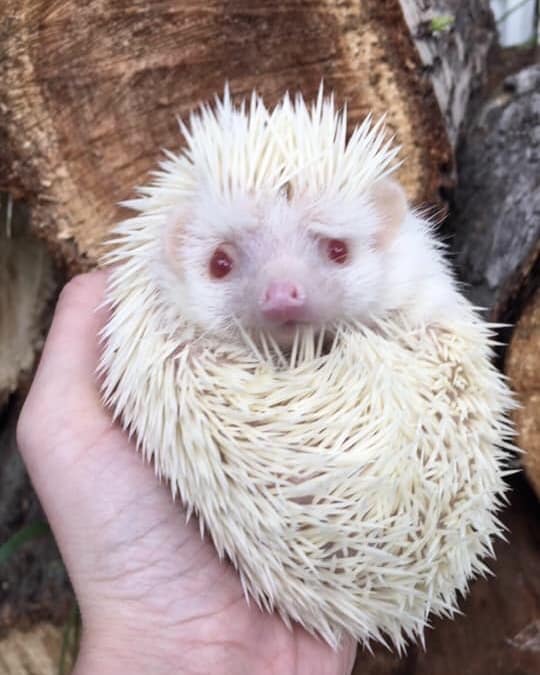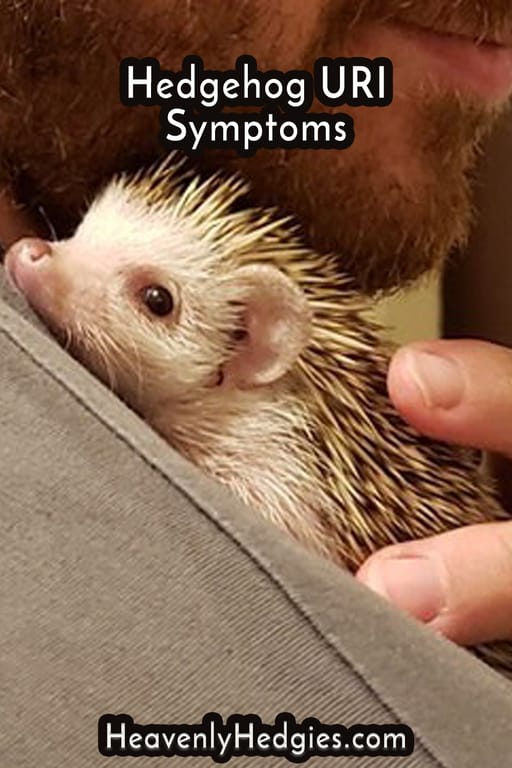Hedgehog URI symptoms can become life threatening if not treated properly. If the following information leads you to believe your hedgehog has an upper respiratory infection, then please make an appointment with your exotic veterinarian as soon as possible. There can be many reasons your hedgehog has this. Additionally, we'll reveal some things you can change environmentally to help avoid a URI in the future. If you want to help them heal sooner, some of our tips may help. Unfortunately, a hedgehog's URI will not go away on its own without proper veterinary care and intervention. Also, you may have to rearrange the way your hedgehog lives, providing a more sterile and quiet home. Hedgehogs do bounce back after this though, so don't panic. Between our information here, the care of your vet, and your hedgehog care-giving instincts, you got this.
ATTENTION: This article is not to replace veterinarian advice, it is to provide you with a foundation of knowledge so you may expand upon it by speaking with your vet. We aim to work with vets, breeders, scientists, owners, and all who care about hedgehogs by providing an up to date collection of information on common hedgehog illnesses and diseases. We are here to help, and for this specific illness, it is necessary that you see a vet for diagnosis. While you wait for your appointment however, please read on.
What is an upper respiratory infection in hedgehogs?
Hedgehog URI symptoms come from irritated and infected nasal passages, their sinuses, oral cavities, back of their oral and nasal cavities (pharynx), and their vocal folds (larynx). Sneezing and shortness of breath are symptoms of a URI, but can also mean something else not related to the respiratory system like a heart condition. Age is not a factor in hedgehog URI symptoms. Respiratory diseases affect young and old hedgehogs, at any point in their lives. It's their environment and lifestyle that mainly contributes to this annoying and sometimes lethal condition. Keep an eye out for self mutilation, as the hedgehog becomes annoyed at the inability to breath, they may attack their noses. Pain medication will also be needed, because unfortunately, this can be painful.

Pathogens in the air they breath and Environmental Parasites
As you may know by living with their poop boots, hedgehogs live with the biology and lifestyle that can easily lead to inner and outer parasites. When first born, a hoglet's respiratory defense systems are not fully developed. So when their young systems are exposed to pathogens in the air, their tiny air sacs inside of the lung fill up with fluid. This is a biological response as their bodies attempt to clean their lungs of the bacteria that may be trapped. Too much of this irritant-filled fluid inside becomes the second stage of a URI like pneumonia. This can happen at any stage of life, especially when housed with other animals.
It isn't uncommon for wild European hedgehogs to develop a URI by eatting slugs and snails which can give them lungworm. But other animals may also carry this disease and transfer it to your hedgehog.
If you hear something similar to the sound clip below, it could be lungworms.
Microscopically, lungworms look like this and cause damage inside, especially as they die out:
The Importance of Clean Air
Ensuring that your quill baby breathes in clean air is highly important, especially during and after having a URI. Unclean air becomes problematic fast; especially second-hand smoke, fecal matter, and heavy perfumes. With the added inhalant pollutants, their lungs may not be so capable of clearing the bronchi of any fluid that naturally builds up, thus increasing the chance of pneumonia. The natural fluid that is present is actually there to clear any foreign molecules and is drained through their nasal cavity, but when that stops working, hedgehog URI symptoms begin to appear.
What exactly Causes URI's In Hedgehogs
A respiratory infection can be due to bacterial, fungal, parasitic, abnormal tissue growths, and non-infectious diseases. It can be in the air, come from their cage environment, transferred between animals, a degenerative condition, or caught from humans too. The bacteria that most commonly causes URI`s is actually already present inside of your hedgehog, and it goes by the name of Bordetella bronchiseptica. While it is a common organism in mammals, if bit by another hedgehog, a lethal case of pnemonia could develop. That is why housing hedgehogs together can be deadly and should not be done. Not just because of the scratches and bites that can happen, but because those scratches and bites can cause an over sharing of vital bacteria which leads to contamination. Hedgehog URI symptoms could also be caused by a specific parasitic infection like lungworm, but as you can see below, there are actually twelve reasons for a hedgehog upper respiratory infection, and counting. Most importantly, an upper respiratory infection may lead to death if not caught early enough, so get to a vet as soon as you can. They must listen to and look at your hedgehogs vital signs and organs to begin treatment.
The Different Types of Hedgehog URI's
| Type of URI Infection | Name of URI Infection |
| Bacterial | Pasteurella Corynebacterium Bodetella Bronchisepticum |
| Fungal | Histoplasmosis |
| Parasitic | Capillaria aerophillum Crenosoma Striatum |
| Neoplasia | Bronchoalveolar Carcinoma Squamous Cell Carcinoma Pulmonary Adenocarcinoma |
| Noninfectious Diseases | Aspiration Pneumonia Pulmonary Hemorrhage Cardiac Disease |
Signs and SYMPTOMS of a Hedgehog URI
At first you may notice your hedgehog is sneezing, has a runny nose, their eyes have discharge, or they have a hard time breathing. The mucus coming from the nose is not clear, but is rather a thick jelly discolored substance. Don't panic! Not all hedgehogs who sneeze have a URI. If the mucus is dark and thick, it may be a good indication a severe URI is starting.

Secondary Infection Signs
If you notice your hedgie becoming very quiet, not moving as much, or is having a hard time breathing, then it is really time to see a vet. The vet should check their lungs for any rattling sounds. Their mouths should also be checked for any ulcers, and an ultrasound or x-ray should be taken to see the amount of fluid or presence of parasites in their lungs. The vet may keep them over night to place a nebulization chamber over them to administer warm air and antibiotics.
Specific Hedgehog URI Symptoms
- Shortness of breath
- Rattling inside the lungs
- Wheezing
- Hard breathing
- Thick nasal discharge
- Sneezing
- Lethargy
- Lack of appetite
HOW CAN A HEDGIE'S URI BE Diagnosed and treated by your vet?
The easiest thing to do after an ultrasound or x-ray would be for your vet to prescribe an antibiotic like Baytril/enrofloxacin and a probiotic like acidophilus./lactobacillus together. A tracheal wash/bronchoalveolar lavage is a method also used, where the vet will pass a tube through their airway and insert a fluid to be collected for examination. A pleural tap (removal of fluid) may be needed if fluid has built up between the lining of the outside of lungs and the chest cavity. In other cases, an endoscopy or even a biopsy may be required.
Testing of Fecal Matter
A fecal microscopy for lungworm eggs may also be collected and examined, so bring in a sample of their stool. A urine sample may also be needed and useful to test for any abnormal cells there. To get the best sample possible, use a clean tote that is raised at one end so any fluids drain to the low end. Don't place any litter or anything absorbent in the tote (including fleece). Simply provide food, water, a plastic hide, and a wheel. The wheel should be placed at the low end. Collect any fluids with a syringe and scoop any feces with a disposable plastic spoon. Place the samples in two separate zip-lock bags to take to your hedgehog's veterinarian.
Prescribing Medication
Antibiotics like Baytril/Enrofloxacin, parasite medication like Ivermectin and fenbendazole, probiotics like Acidophilus and Doxycycline will most likely be prescribed. So could mucous thinners, and prescription food. Follow through on all the medications given and follow instructions carefully, this could be a lethal situation if not handled properly. If you need a video on how to give your hedgehog their medication, see this:
How To Help Your Hedgehog's URI At Home
How to treat and manage it
Make sure your hedgehog is drinking enough water to help flush the infection out of their system. Click here to see our hedgehog water intake guide to determine how much water you should encourage your hedgehog to drink. You may need to offer it in a syringe if your hedgehog is dehydrated. Consider using an air purifier and a warm mist humidifier paired with a hygrometer to bring the humidity to 45%. It may be tempting, but do not use vapor rub or eucalyptus or any kind of essential oils.
Reducing Stress In The Home

Reduce stress for them by keeping them in darkness and increasing the amount of oxygen that is in the air. You can do that by adding an air purifier and changing your home furnace filters more often. Offer some new hides inside their cage and reduce the amount of noise if possible inside of the home. Bonding time may also need to be cut back until they feel better, but that is up to you to decide. If your hedgehog is close with you and bonded already, then calm cuddles couldn`t hurt. Remove your hedgehog from other animals and make sure your dogs are vaccinated against kennel cough.
Decreasing Exercise and Harmful Things to Watch Out For
See if their vet recommends that their wheel be taken away until the infection clears, just to encourage them to relax and sleep as much as they can. If they do, find out how long exercise should be avoided. You should still be able to let them out of their cage for some running around time though. Ask their vet first though. Hedgies are known to self mutilate, and have been found to attack their noses if the mucus and inability to breath properly gets too much. The use of antibiotics may turn their poop green, indicating a need for probiotics or another vet visit if it has not returned to normal stools within a few days. Like we mentioned in our poop article, diarrhea that lasts more than 48 hours despite your best efforts to aid it should be seen by a vet.
Needed Changes To Their Environment
Needed Changes To Their Environment
Remove all bedding, litter, and sand baths that may be causing any traces of dust to be kicked up. Cage bedding and litter choices often tell you have much dust the product contains. Begin purifying the air with an air purifier, and isolate your hedgehog away from other animals. Always keep the cage temperature at the recommended settings between 74°F – 80°F /23°C – 26.5°C. And during the time of infection, provide a warm humidifier at about 45% with the help of a hygrometer. Switching to fleece bedding is also recommended.
Ultimately, their environment needs to be as clean as possible, meaning extra cleaning in the room they are in should also be done to remove dust allergens. Discontinue the use of any irritating sprays such as fabric sprays, air fresheners, hair sprays, disinfectant sprays, and perfumes. As you and your hedgehog breath in these things, tiny sacs inside of our lungs fill up and if the immune system is compromised or weak in any way, that build up of fluid may not necessarily be able to drain as normal lungs would, creating a need for clean air here on out.
Summary of Hedgehog URI Symptoms

URI Symptom Recognition
Trying to catch the symptoms of an upper respiratory infection early makes it easier to prevent secondary stages of the illnesses. URI's can indicate a different reason behind the symptoms or can be a tell-tale sign of an aggressive infection – both need veterinarian care right away. Hedgies are prone to parasitic infection because of their biology and habits, so keeping them away from other hedgehogs and other animals may reduce occurrences. It may also be helpful to try these litter training methods here, and to keep up with regular foot baths.
Identifying Environmental Factors
Upper respiratory infections may be caused by several factors, so it is important to think of where the hedgehog may have caught the infection initially. Also, try to think of ways to improve their environments. Plastic tote bins are not our favorite and we don't recommend them for many reasons. Even if you drill aerating holes in the sides of them, the material can build up bacteria and isn't a good source of clean air for your hedgie to inhale. To learn what kind of cage a hedgehog needs, please read our hedgehog cage article.
We strongly recommend air purifiers, keeping up with the cleaning in and around their cage, keeping them at their appropriate habitat temperature, ensuring their supplies are dust free, and watching them on a camera to catch any odd signs of illness. Feel free to leave any questions or share your stories about hedgehog upper respiratory infections you may have dealt with below in the comments!
You can stay on top of any illness if you follow the tips we provide on our website. Don't see your hedgehog's illness or symptom on our website yet? Ask Quilly a question here! We hope this helped you and that your heavenly hedgie feels better soon!





